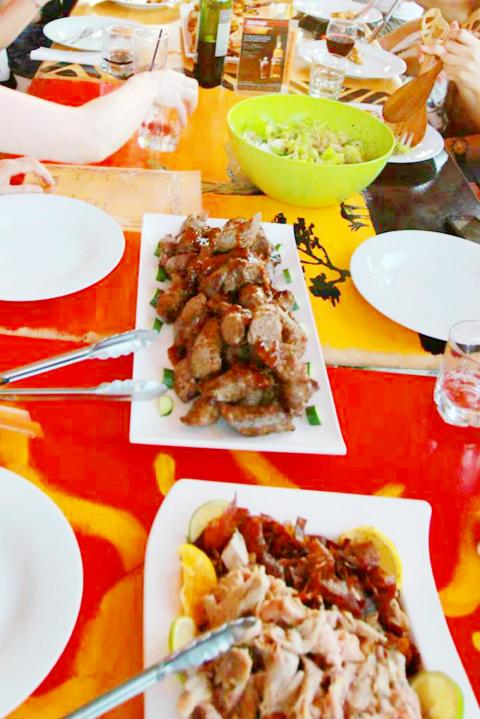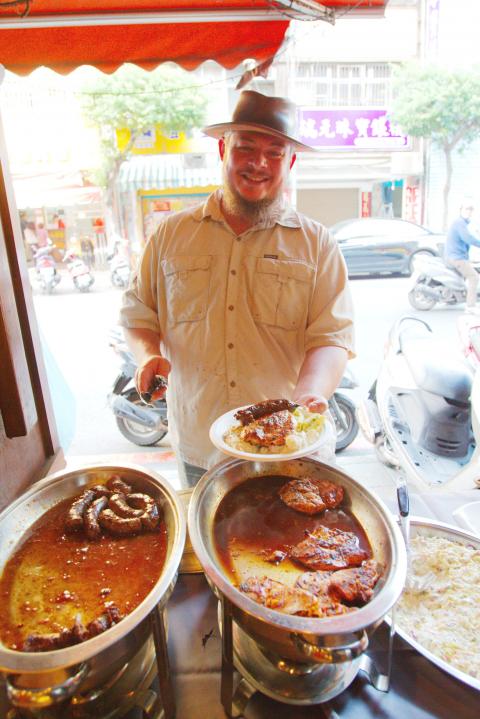“Boerewors and biltong,” says chef and braai master Etienne Mare, referring to farmer’s sausage and dried, cured meat — food that is essential to hosting a successful South African-style barbecue.
“I think all South Africans hold these two things as being central to our identity as a nation.”
Braai — which is Afrikaans for “grill” — is an essential part of South African culture, and some South African expats will be giving us a taste of this tomorrow afternoon at The Station, an outdoor cocktail bar near Taipei Main Station run by another South African, Jono Cowling. “Braai and Beats” will start at 2pm and last well into the night. There will be boerewors and other meats, along with cocktail pitchers and beer.

Photo courtesy of Tobie Openshaw
Mare will be behind the grill and Cowling will be looking after the bar, while Eben Pretorius, also known as The Cook, The Thief, will be deejaying. The idea, Mare says, is to recreate everything you’ll find at a traditional braai — down to the South African music, drinks and vibe.
“The braai is probably the single most important aspect of social networking — at least offline — for birthdays, holidays, anniversaries and sports events,” Mare tells the Taipei Times.
Whenever South Africans have any type of gathering, the first consideration often would be to have a braai. In southern hemisphere South Africa, even Christmas is likely to be spent at the beach and having a braai. The weekly Sunday braai is a family tradition that ostensibly gives mom time off from the kitchen while dad heroically cooks in the yard — but of course, the reality is that mom and the sisters have as much work to do, preparing salads and other staples that go with a braai — as well as cleaning up afterwards.

Photo courtesy of Tobie Openshaw
Kids learn to grill from a young age, and for many boys, helping dad at the braai is a rite of passage.
“Even if you didn’t want to, that much exposure makes you competent at the very least,” Mare says.
THE SECRET CRAFT OF THE SAUSAGE
Seeing as Taipei has a significant South African community, they’ve been able to host quite a number of events over the past few years. The biggest one held so far was South Africa Day in Huashan 1914 Creative Park in 2010, but the organizers found that larger-scale events were challenging to manage as they put a burden on the small businesses who run it. As such, they’re hoping that tomorrow’s braai will be a cozy but lively affair.
It’s probably a good idea to keep the event a manageable size too, since grillers can get quite feisty when it comes to their sausages.
“Competition would be intense if we ever had a Taiwan event with multiple chefs cooking boerewors,” Mare says. “Mutual respect, but intense competition.”
As for the process of making a good boerewors, it’s quite labor intensive, and as Mare adds, “most of that is a trade secret.”
All he can reveal is that boerewors must be 70 percent beef, not contain any grain products or fillers, and be ground at least three times by hand. It takes him and his wife up to six hours to complete a 50kg batch, including preparing the spices.
When all of that is done, it’s more than worth it. After all, every chef likes to see his customer satisfied, and tomorrow’s sausages sizzling on the grill will not disappoint.

May 26 to June 1 When the Qing Dynasty first took control over many parts of Taiwan in 1684, it roughly continued the Kingdom of Tungning’s administrative borders (see below), setting up one prefecture and three counties. The actual area of control covered today’s Chiayi, Tainan and Kaohsiung. The administrative center was in Taiwan Prefecture, in today’s Tainan. But as Han settlement expanded and due to rebellions and other international incidents, the administrative units became more complex. By the time Taiwan became a province of the Qing in 1887, there were three prefectures, eleven counties, three subprefectures and one directly-administered prefecture, with

Taiwan Power Co (Taipower, 台電) and the New Taipei City Government in May last year agreed to allow the activation of a spent fuel storage facility for the Jinshan Nuclear Power Plant in Shihmen District (石門). The deal ended eleven years of legal wrangling. According to the Taipower announcement, the city government engaged in repeated delays, failing to approve water and soil conservation plans. Taipower said at the time that plans for another dry storage facility for the Guosheng Nuclear Power Plant in New Taipei City’s Wanli District (萬里) remained stuck in legal limbo. Later that year an agreement was reached

What does the Taiwan People’s Party (TPP) in the Huang Kuo-chang (黃國昌) era stand for? What sets it apart from their allies, the Chinese Nationalist Party (KMT)? With some shifts in tone and emphasis, the KMT’s stances have not changed significantly since the late 2000s and the era of former president Ma Ying-jeou (馬英九). The Democratic Progressive Party’s (DPP) current platform formed in the mid-2010s under the guidance of Tsai Ing-wen (蔡英文), and current President William Lai (賴清德) campaigned on continuity. Though their ideological stances may be a bit stale, they have the advantage of being broadly understood by the voters.

In a high-rise office building in Taipei’s government district, the primary agency for maintaining links to Thailand’s 108 Yunnan villages — which are home to a population of around 200,000 descendants of the Chinese Nationalist Party (KMT) armies stranded in Thailand following the Chinese Civil War — is the Overseas Community Affairs Council (OCAC). Established in China in 1926, the OCAC was born of a mandate to support Chinese education, culture and economic development in far flung Chinese diaspora communities, which, especially in southeast Asia, had underwritten the military insurgencies against the Qing Dynasty that led to the founding of